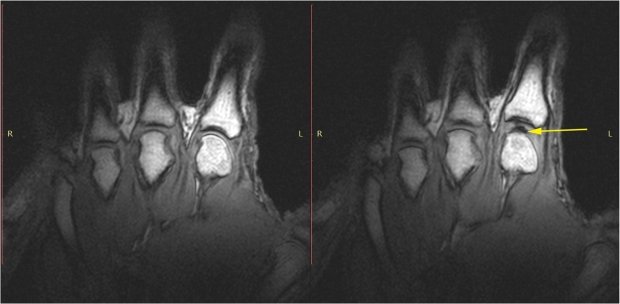"The bubble is gas that was dissolved in the joint fluid but comes out of solution when the pressure drops as the joint is stretched."
Canadian researchers have solved a mystery that has tantalised humankind since the very dawn of recorded time – why do knuckles crack?!
Dr Chris Smith of The Naked Scientists told This Way Up's Simon Morton that there are two prevailing theories. One theory, suggested by two UK scientists in 1947, is that joints pop and click when low-pressure triggers a bubble to pop into existence inside the joint space.
However, in the 1970s, a second team of British researchers offered an alternative view; that the sound was not produced by a bubble forming in the joint, but instead when it collapsed afterwards. This process, called cavitation, became a widely accepted explanation for why joints crack.
Now University of Alberta researcher Gregory Kawchuk and his colleagues, writing in PLoS One, used an MRI scanner to observe exactly what happened inside the knuckle-joint of a team member at the precise moment it went crack.
The MRI images show the sudden appearance of a dark void, corresponding to a gas bubble inside the finger joint, at the same time the sound is produced.
"The bubble is gas that was dissolved in the joint fluid but comes out of solution when the pressure drops as the joint is stretched," said Mr Kawchuk. "It then hangs around for quite a long time afterwards and slowly disappears as it dissolves again. While this is happening, the joint can't be cracked again." This shows that the sound can only be produced by the bubble appearing, rather than disappearing as the later theory had speculated.
"Rather than cavitation, when bubbles collapse noisily, our results fit more with a process called tribonucleation," said Mr Kawchuck. "This produces a low-pressure area and that's what leads to the bubble appearing."

Static images of the hand in the resting phase before cracking (left). The same hand following cracking with the addition of a post-cracking distraction force (right). Note the dark, interarticular void (yellow arrow). Image: PLOS: (CC BY 4.0)
Dr Chris Smith of The Naked Scientists told This Way Up's Simon Morton the results clear the way for scientists to consider another long-standing joint-cracking-conundrum: is the process linked to damage to the joint or even arthritis?

The metocarpophaangeal (MCP) joint of interest centred over the bore of the radiofrequency coil (middle). The participant’s hand within the imaging magnet (right). Image: PLOS: (CC BY 4.0)

